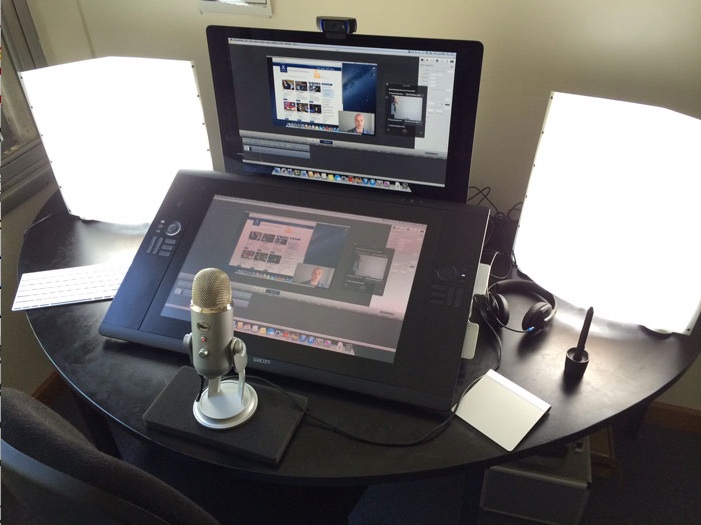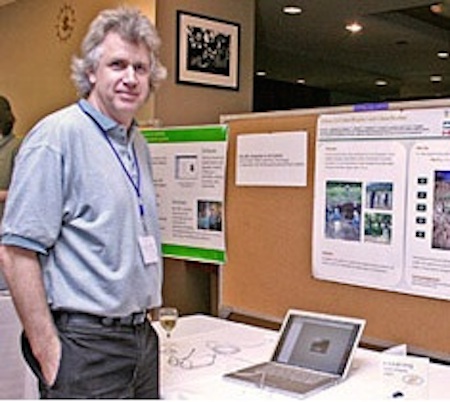
Image: © University of Melbourne, 2014
8.7.1 Institutional readiness for teaching with technology
One of the critical issues that will influence the selection of media by teachers and instructors is
- the way the institution structures teaching activities;
- the instructional and technology services already in place;
- the support for media and technology use that their institution provides.
If an institution is organised around a set number of classroom periods every day, and the use of physical classrooms, the teachers are likely to focus mainly on classroom delivery. As Mackenzie was quoted in Section 8.1: ‘Teachers have always made the best of whatever they’ve got at hand, but it’s what we have to work with. Teachers make due.’ The reverse is equally true. If the school or university does not support a particular technology, teachers and instructors quite understandably won’t use it. Even if the technology is in place, such as a learning management system or a video production facility, if an instructor is not trained or oriented to its use and potential, then it will either be underused or not used at all.
Most institutions that have successfully introduced media and technology for teaching on a large scale have recognized the need for professional support for faculty, by providing instructional designers, media designers and IT support staff to support teaching and learning. Some institutions also provide funding for innovative teaching projects.
A major implication of using technology is the need to reorganise and restructure the teaching and technology support services in order to exploit and use the technology efficiently. Too often technology is merely added on to an existing structure and way of doing things. Reorganisation and restructuring is disruptive and costly in the short-term, but usually essential for successful implementation of technology-based teaching (see Bates and Sangrà, 2011, for a full discussion of management strategies for supporting the use of technology for teaching in higher education, and Marshall, 2007, for a method to assess institutional readiness for e-learning).
Because of the inertia in institutions, there is often a bias towards those technologies that can be introduced with the minimum of organisational change, although these may not be the technologies that would have maximum impact on learning. These organisational challenges are extremely difficult, and are often major reasons for the slow implementation of new technology.
8.7.2 Work with professionals

Even those experienced in using media for teaching and learning would be wise to work with professional media producers when creating any of the media discussed in this chapter (with the possible exception of social media). Indeed, it is usually useful if not essential to work also with an instructional designer to determine before too much work is done which media are likely to be the most appropriate. It is important for the choice of technology to be driven by educational goals, rather than starting with a particular medium or technology in mind.
There are several reasons for working with professionals:
- they understand the technology and as a result will enable you to develop a better product more quickly than working alone;
- two heads are better than one: working collaboratively will result in new and better ideas about how you could be using the medium;
- instructional designers and professional media producers will usually be familiar with project management and budgeting for media production, enabling resources to be developed in time and on budget. This is important as it is easy for teachers or instructors to get sucked into spending far more time than necessary on producing media.
The key point here is that although it is now possible for teachers and instructors to produce reasonably good quality audio and video on their own, they will always benefit from the input of professionals in media production.
8.7.3 Questions for consideration
1. How much and what kind of help can I get from the institution in choosing and using media for teaching? Is help easily accessible? How good is the help? Do the support people have the media professionalism I will need? Are they up to date in the use of new technologies for teaching?
2. Is there possible funding available to ‘buy me out’ for a semester and/or to fund a teaching assistant so I can concentrate on designing a new course or revising an existing course? Is there funding for media production?
3. To what extent will I have to follow ‘standard’ technologies, practices and procedures, such as using a learning management system, or lecture capture system, or will I be encouraged and supported to try something new?
4. Are there already suitable media resources freely available that I can use in my teaching, rather than creating everything from scratch? Can I get help from the library for instance in identifying these resources and dealing with any copyright issues?
If the answers are negative for each of these questions, you would be wise to set very modest goals initially for using media and technology. Nevertheless the good news is that it is increasingly easy to create and manage your own media such as web sites, blogs, wikis, podcasts and even simple video production. Furthermore students themselves are often capable and interested in participating or helping with creating learning resources, if given the chance. And above all, there is an increasing amount of really good educational media coming available for free use for educational purposes, as we shall see in Chapter 10.
References
Bates, A. and Sangrà, A. (2011) Managing Technology in Higher Education San Francisco: Jossey–Bass/John Wiley and Co.
Marshall, S. (2007). eMM Version Two Process Assessment Workbook Version 2.3.Wellington NZ: Victoria University of Wellington